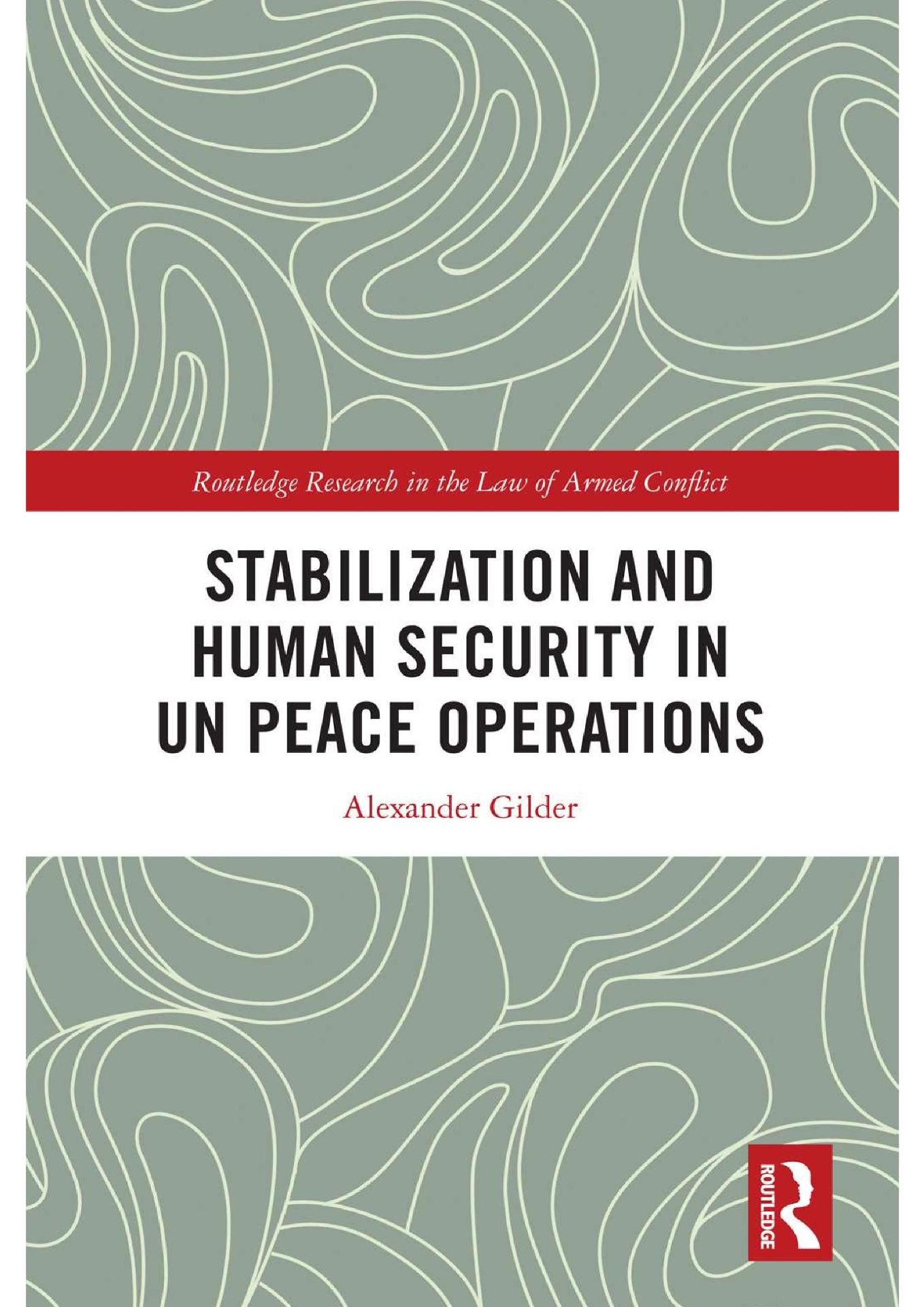Andrea Maria Pelliconi, Alex Gilder, Kseniya Oksamytna
United Nations (UN) peace operations are typically a troubled sea to navigate. Peace operations operate in increasingly hostile environments and have to manoeuvre through dangerous waters: continuing insurgencies, ineffective state presence, widespread violence and insecurity, and even terrorist attacks. Stabilisation efforts may carry human rights and humanitarian risks, especially when they come with heavy militarisation, or with mandates that leave the mission without a clear political direction. These dangers bring about potential shortcomings in effectiveness, and even legitimacy challenges. Yet peace operations remain a crucial tool to attempt to advance peace and stability.
 A passionate, critical commentator of peace operations, Dr Alexander investigates the relationship between the concept of ‘human security’ and UN stabilization mandates, as they seek to meet the lofty expectations of securing conflict zones, achieving national reconciliation, and rebuilding state legitimacy. Dr Gilder’s book Stabilization and Human Security in UN Peace Operations (Routledge 2022), based on his PhD dissertation at City Law School, was launched on 9 March 2022. The event was convened by Dr Andrew Wolman, co-convenor of City’s International Law and Affairs Group (ILAG), and the book was discussed by Dr Kseniya Oksamytna, Lecturer in International Politics (Foreign Policy/Security) at City.
A passionate, critical commentator of peace operations, Dr Alexander investigates the relationship between the concept of ‘human security’ and UN stabilization mandates, as they seek to meet the lofty expectations of securing conflict zones, achieving national reconciliation, and rebuilding state legitimacy. Dr Gilder’s book Stabilization and Human Security in UN Peace Operations (Routledge 2022), based on his PhD dissertation at City Law School, was launched on 9 March 2022. The event was convened by Dr Andrew Wolman, co-convenor of City’s International Law and Affairs Group (ILAG), and the book was discussed by Dr Kseniya Oksamytna, Lecturer in International Politics (Foreign Policy/Security) at City.
In applying the multidisciplinary concept of human security to examine the role of the individual in international law generally, and in peace operations specifically, Alex’s work lies at the intersection between legal and International Relations scholarship. In his own terms, human security is a concept which is rights- and norms-based; premised on the notion of human vulnerability; and employs a ‘protection and empowerment model.’ The question underpinning Alex’s research is whether and to what extent UN peace operations have mainstreamed and institutionalised human security in their mandates. Alex also questioned whether typically broad mandates of contemporary missions to protect civilians, implement peacebuilding strategies, and – in some situations – consult with local communities and authorities on how best to secure peace, are sufficient to demonstrate an effective human security approach.
The book is divided into three parts. Part I outlines the emergence of stabilisation and other trends in peacekeeping practice and outlines an analytical framework of human security. Part II applies the analytical framework to case studies of the United Nations Multidimensional Integrated Stabilization Mission in Mali (MINUSMA), Multidimensional Integrated Stabilization Mission in the Central African Republic (MINUSCA), and Mission in South Sudan (UNMISS) examining such aspects as human rights, empowerment, protection, and vulnerability. Part III draws out several concerns that arise from stabilisation mandates, including the militarisation of UN peace operations and the consequences under international humanitarian law; the risks of close cooperation with the host state during engagement in counter-terror activities; and the potential clash between peacebuilding activities and militarisation.
The three case-studies analysed in the book offer a fertile ground for discussion and comparative investigation of the application of the human security approach to contexts that, despite some similarities, present distinctive characteristics and challenges. In briefly presenting some of the findings of his research, Dr Gilder’s showed how specific initiatives promoting human rights and inclusive dialogue are visible in MINUSMA. In the Malian context, the main focus appears to be on protection from physical violence. Of great relevance in the mandate is the recognition of vulnerability, particularly of women and children, and actions taken to build resilience. Furthermore, the efforts towards national reconciliation have included attempts to incorporate women’s voices. At the same time, however, it appears that a more comprehensive understanding of vulnerability would be needed to fully realise a holistic human security approach, beyond the focus on women and children. As an example, Dr Gilder noted that the initial mandate of MINUSMA also paid attention to the vulnerability of people with disabilities; however, this focus later disappeared during subsequent mandate renewal negotiations.
In the Central African Republic (CAR), the mandate of MINUSCA has focused more explicitly on the rule of law. The specific context of the CAR required the consolidation of a legal order, and especially the re-establishment of the criminal judicial system. To this end, the focus here is less on physical security, and more on general empowerment, encouragement of communities’ participation, and rebuilding of social ties. Thus, MINUSCA’s mandate is less centred on vulnerable populations than MINUSMA’s, and more concerned with supporting dialogue and rule of law. While the mandate does include protection of women and children from sexual violence, and even protection of elderly people, the focus on women’s empowerment is more limited than in MINUSMA, and broader scope for general community empowerment and reconciliation is provided. This includes the establishment of a Truth, Justice, Reparation and Reconciliation Commission (TJRRC), later incorporated into the government, and ongoing dialogue with communities. However, the mandate does not provide significant details on the priorities to be achieved, and how to concretely include communities in the decision-making process.
Lastly, the mission in South Sudan, UNMISS, is yet again characterised by another set of context-specific difficulties that affect the ability to implement a human security approach. In this context, one of the most challenging aspects is ensuring protection of civilians from non-conflict related crimes, especially within the so-called ‘protection of civilians sites’ that housed hundreds of thousands of civilians.
Drawing from these observations, Alex identified a number of risks and challenges for UN peacekeeping and stabilisation operations, deriving directly from the scope of mission mandates, that could impair the effective application of a human security approach. The first risk concerns the increased militarisation of UN peace operations, which – Dr Gilder argues – is likely to be incompatible with human security per se. In fact, there are potential rule of law related risks arising from clashes between peacebuilding activities and militarisation. In this respect, Dr Gilder noted that missions had a great focus on physical protection, but disregarded the fact that militarisation puts civilians at increasing risk, and intensifies violence. Also, more needs to be done about violence prevention. Militarisation, in fact, could entail specific consequences and responsibilities under international humanitarian law, which should be taken into account when designing mandates. Another set of risks derives from the engagement in counterterror activities in close cooperation with the host state – and, at times, even other states, like France in Mali. This cooperation could potentially limit the mission’s focus on human security, prioritizing efficiency instead. For example, Dr Gilder noted how authorities in Mali and the CAR violated international human rights and humanitarian law; therefore, UN operations should be cautious when cooperating closely with such partners, and support for the host governments should follow human rights due diligence. Therefore, it is suggested, the UN could use a holistic understanding of human security to refocus its peace operations.
Building upon these considerations, Dr Oksamytna comments pointed out how Dr Gilder’s’s book contributes to peace operations’ scholarship at three different levels: conceptually, empirically, and methodologically.
Conceptually, Dr Oksamytna highlighted, that the book examines how the notion of human security has been operationalised in UN practice. The book thus speaks to the growing literature at the intersection of international law and International Relations that examines how rules and norms are interpreted, contested, and implemented. The book discusses with great nuance how the implementation of human security in UN peacekeeping presents difficult dilemmas and how well-meaning initiatives can be misguided and counterproductive, as the literature on unintended consequences of peacekeeping has warned for years. For example, when UN peacekeepers support national armies or security agencies in conducting counter-terrorism operations, Blue Helmets are at least indirectly liable for abuses that national soldiers or police commit. Such abuses diminish a population’s human security, despite the ultimate goal of enhancing it by reducing the threat of terrorism. This is one of the persistent dilemmas that UN peace operations encounter in trying to operationalise human security. At the same time, Dr Oksamytna noted, by documenting UN peacekeepers’ engagement in non-military activities, the book persuasively dispels a misconception that has dominated the peacekeeping and peacebuilding literature since the publication of Séverine Autesserre’s The Trouble with the Congo (2010): the assumption that UN peacekeepers do not address local conflicts. Dr Gilder’s book documents manifold ways in which peacekeepers work to promote inter-communal, local-level reconciliation: through outreach activities, peace conferences, training on conflict resolution, and peace forums for women and youth. This work, often carried out by civil affairs officers, suggests that we need to pay closer attention to the contribution of peacekeeping officials who make up the so-called ‘civilian component’ of UN missions: experts on human rights, rule of law, governance reform, and information and communication.
Moving on to the book’s empirical contribution, Dr Oksamytna noted how the book is the first to comparatively analyse the unique challenges faced by UN missions in each of the three case-studies examined in the book. MINUSMA supports the host government that fights terrorist armed groups, and designating all challengers to its authority as terrorists may complicate attempts at dialogue. MINUSCA has addressed not only conflict-related violence but also criminal violence, using its innovative mandate for ‘urgent temporary measures’ that allow apprehending individuals who pose a threat to public security. UNMISS had to shift from supporting the host government to protecting civilians after the government became a party to the civil war. It ended up guarding residents of the so-called ‘protection of civilians sites’ from both external attacks and disturbances within the sites.
Finally, Dr Oksamytna discussed how the book’s methodological contribution lies in its meticulous analysis of UN Security Council’s resolution and UN Secretary-General’s reports. Dr Gilder’s work is not based on fieldwork but on the analysis of these primary sources, their language, and related policy developments. This investigation allows for an in-depth assessment of the UN’s approach to human security in the three peacekeeping operations.
Alex’s book can be purchased here.

Leave a Reply